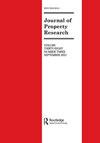House price prediction with gradient boosted trees under different loss functions
IF 2.3
Q2 URBAN STUDIES
引用次数: 11
Abstract
ABSTRACT Many banks and credit institutions are required to assess the value of dwellings in their mortgage portfolio. This valuation often relies on an Automated Valuation Model (AVM). Moreover, these institutions often report the models accuracy by two numbers: The fraction of predictions within and range from the true values. Until recently, AVMs tended to be hedonic regression models, but lately machine learning approaches like random forest and gradient boosted trees have been increasingly applied. Both the traditional approaches and the machine learning approaches rely on minimising mean squared prediction error, and not the number of predictions in the and range. We investigate whether introducing a loss function closer to the AVMs actual loss measure improves performance in machine learning approaches, specifically for a gradient boosted tree approach. This loss function yields an improvement from to of predictions within of the true value on a data set of transactions from the Norwegian housing market between 2013 and 2015, with the biggest improvements in performance coming from the lower price segments. We also find that a weighted average of models with different loss functions improves performance further, yielding of the observations within of the true value.不同损失函数下梯度增强树的房价预测
许多银行和信贷机构被要求评估其抵押贷款组合中的住房价值。这种估值通常依赖于自动估值模型(AVM)。此外,这些机构经常通过两个数字来报告模型的准确性:预测值在真实值之内和距离真实值的比例。直到最近,avm倾向于享乐回归模型,但最近像随机森林和梯度增强树这样的机器学习方法已经越来越多地应用。传统方法和机器学习方法都依赖于最小化均方预测误差,而不是和范围内的预测数量。我们研究了引入一个更接近avm实际损失度量的损失函数是否能提高机器学习方法的性能,特别是对于梯度增强树方法。根据2013年至2015年挪威房地产市场交易数据集,该损失函数的预测值在真实价值范围内有所改善,其中最大的性能改善来自较低价格部分。我们还发现,具有不同损失函数的模型的加权平均进一步提高了性能,产生了在真实值范围内的观测值。
本文章由计算机程序翻译,如有差异,请以英文原文为准。
求助全文
约1分钟内获得全文
求助全文
来源期刊

Journal of Property Research
URBAN STUDIES-
CiteScore
3.80
自引率
5.30%
发文量
13
期刊介绍:
The Journal of Property Research is an international journal. The title reflects the expansion of research, particularly applied research, into property investment and development. The Journal of Property Research publishes papers in any area of real estate investment and development. These may be theoretical, empirical, case studies or critical literature surveys.
 求助内容:
求助内容: 应助结果提醒方式:
应助结果提醒方式:


